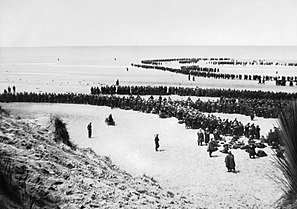Operation Dynamo: A Tactical Overview
Operation Dynamo, the codename for the Dunkirk evacuation, stands as one of the most remarkable military undertakings of World War II. On May 26, 1940, British Vice-Admiral Bertram Ramsay initiated the operation with the goal of rescuing the encircled Allied forces from the beaches of Dunkirk, France. The operation concluded successfully on June 4, 1940, marking the completion of the “miracle of Dunkirk,” a term that has since become synonymous with extraordinary resilience and strategic ingenuity.
The evacuation required the mobilization of a diverse fleet of over 800 vessels, including Royal Navy destroyers, merchant marine boats, fishing boats, pleasure craft, and lifeboats. This armada, often referred to as the “Little Ships of Dunkirk,” played a crucial role in rescuing an astounding 338,226 Allied troops. The strategic planning behind this operation involved meticulous coordination and rapid decision-making under dire circumstances. Despite the intense German bombardment and logistical challenges, such as navigating the shallow waters and ensuring the protection of evacuees, the operation managed to achieve its objective.
Historical accounts and military records reveal the high stakes and complexities involved. The troops on the beaches faced relentless air and ground attacks from German forces, which compounded the urgency of the evacuation efforts. Eyewitness accounts from soldiers and naval personnel provide vivid descriptions of the chaos and bravery witnessed during those harrowing days. The successful extraction of such a large number of troops not only saved lives but also bolstered Allied morale, reinforcing the resolve to continue the fight against Axis powers.
Dunkirk’s significance extends beyond the immediate tactical victory. It underscored the importance of unity and cooperation among the Allied forces and marked a pivotal moment in the broader context of World War II. The completion of the “miracle of Dunkirk” on June 4, 1940, remains a testament to the power of strategic planning, collective effort, and unwavering determination in the face of overwhelming adversity.
The Impact and Legacy of the Dunkirk Evacuation
The successful completion of the “Miracle of Dunkirk” on 4th June 1940 had profound implications for World War II. The evacuation not only saved the lives of over 338,000 Allied soldiers but also significantly bolstered British morale during a time of dire need. The event became a powerful symbol of hope and resilience, demonstrating that even in the face of overwhelming odds, unity and determination could lead to extraordinary outcomes.
The strategic benefits of the Dunkirk evacuation were immense. The preservation of the British Expeditionary Force (BEF) allowed the Allies to regroup and continue their resistance against the Axis powers. This crucial act of saving experienced soldiers meant that the British military retained a core of trained and battle-hardened personnel, which proved invaluable in the subsequent phases of the war. The Dunkirk evacuation provided a psychological boost to the British public and military, reinforcing the belief that victory was still attainable despite the challenging circumstances.
Personal stories and testimonies from those involved in the evacuation provide a compelling human aspect to the historic event. Soldiers recounted harrowing experiences of wading through chest-deep water under enemy fire, while civilian boat owners described their perilous journeys across the English Channel to rescue stranded troops. These narratives highlight the extraordinary bravery and solidarity exhibited by both military personnel and civilians, underscoring the collective effort that made the “Miracle of Dunkirk” possible.
Historical analyses and documentaries further illuminate the significance of Dunkirk’s legacy. Scholars have noted that the evacuation had a ripple effect on the broader war effort, influencing strategic decisions and boosting Allied morale. Documentaries such as “Dunkirk” (2017) by Christopher Nolan provide visual and emotional insights into the event, bringing the story to life for contemporary audiences and ensuring that the legacy of Dunkirk endures.
Ultimately, the “Miracle of Dunkirk” serves as a testament to the resilience and fortitude of those involved. The successful evacuation on 4th June 1940 not only altered the course of World War II but also left an indelible mark on history, symbolizing the power of collective courage and determination.

